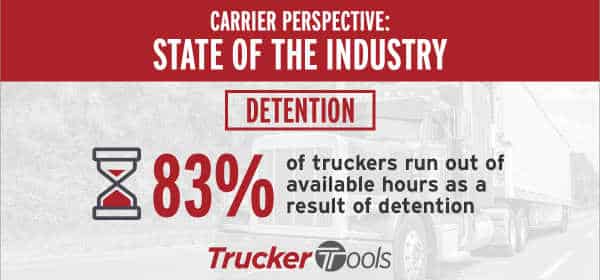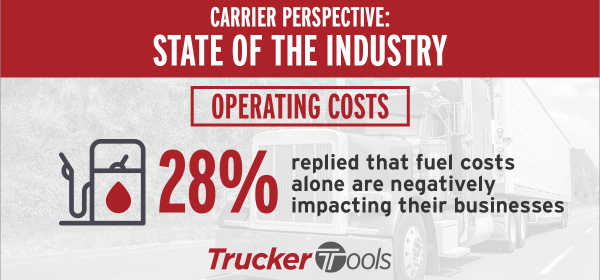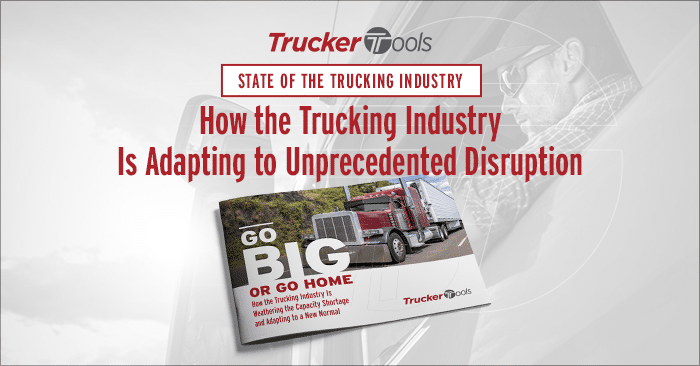In the last year and a half, the disruption and volatility caused by the COVID-19 pandemic have redrawn freight lanes, altered supply chains, tightened truck capacity and pushed rates to historic highs. Add labor shortages, port congestion, depleted inventories and rising operating costs to the equation and it’s without a doubt a challenging time to be working in the transportation sector.
To gain insight into the challenges that the trucking industry is facing and to understand how it’s adapting, Trucker Tools recently polled nearly 400 owner operators and carriers about their day-to-day operations and how they’re dealing with the disruptions brought about by the pandemic. In the survey, we asked owner operators and carriers about how they’re dealing with this new normal and leveraging technology to overcome some of these challenges.
Read on to find out what insights our survey uncovered and to learn how the trucking industry is adapting to unprecedented disruption with the help of real-time technology.
Detention a Major Problem for Owner Operators, Carriers and the Entire Industry
The results from the survey reveal that detention is one of the top problems with which owner operators and carriers currently are contending. Staffing shortages and COVID-19 outbreaks at both at shipper and receiver docks are contributing to higher dwell times for owner operators and carriers. Of those we surveyed, 60 percent reported that they are detained for more than two hours on each load. Approximately 65 percent of those surveyed also reported that detention pay has not increased or improved within the last 12 months.
While it’s easy to label detention as purely a carrier or shipper/receiver problem, the reality is that driver detention is a problem for all stakeholders in the transportation industry. When an individual driver waits to load or unload their trailer for three or four hours on a load, their truck capacity is no longer available to transport other loads during that three or four hour time period, which essentially removes the capacity from the general market. Multiply that detention time by the 3.5 million truckers we have running freight in the United States and you have a widespread driver detention problem that essentially shrinks the amount of capacity available in freight markets nationwide.

Some owner operators, carriers and freight brokers are using real-time technology to reduce and better document driver detention time. Freight brokers on Trucker Tools’ real-time load tracking platform can use the platform’s geofencing capabilities to be notified in their TMS any time that a driver’s detention time goes above the industry-standard two hour mark. The notification from the platform serves as a prompt for the broker to contact the shipper/receiver to see if the delay can be resolved so that the driver can get moving. When drivers use the Trucker Tools driver app for load tracking, they can take screenshots of their recorded dwell time in order to justify being paid detention pay. The screen shots serve as proof from a third-party that the detention did, in fact, take place.
Higher Operating Costs Pushing Rates Up, Squeezing Carriers
The survey revealed that high operating costs are a major challenge for owner operators and carriers, as well. Of those surveyed, approximately 50 percent reported that their businesses are negatively impacted by the cost of fuel, truck maintenance, parking, insurance and driver pay. Many of the truckers and carriers surveyed expressed concern about the rising cost of diesel fuel, in particular — and for good reason. The average per-gallon price of diesel in the United States recently hit a seven year high — and it could go even higher as we get deeper into peak shipping season.

As several owner operators and carriers noted in the survey’s comments section, freight rates aren’t always keeping pace with increasing operating costs. Insurance premiums for Class 8 trucks have increased significantly in recent years, often by double digits from year to year. Catastrophic storms, inflation, higher risk on the spot market and higher repair costs all are driving premiums up. The cost of new and used trucks, as well as replacement parts, all have increased, further impacting the profit margins of owner operators and carriers..
Many in the trucking industry are using real-time technology like Trucker Tools’ mobile app to manage their expenses. To date, more than 1.3 million drivers and carriers have downloaded the free app. With the Trucker Tools app, drivers can locate the cheapest fuel on their route and quickly find weigh scales, rest areas, parking, truck stops, repair shops, food, restaurants, Wal-Mart stores and more with a few taps on their smart phones. Drivers also can use the app to find and book loads with brokers and to track loads for brokers. All of the app’s tools and features reduce driver downtime and increase efficiency, which ultimately helps owner operators and carriers increase profit margins.
For more of our survey results and to find out how owner operators and carriers are using technology to foster relationships with freight brokers, read “Go Big or Go Home: How the Trucking Industry Is Weathering the Capacity Shortage and Adapting to a New Normal“.






